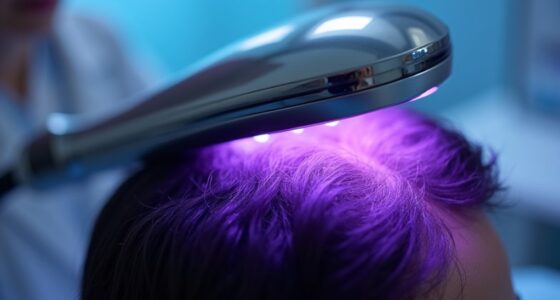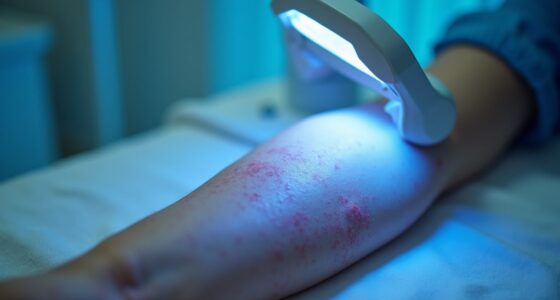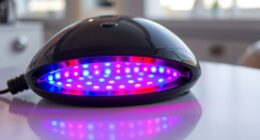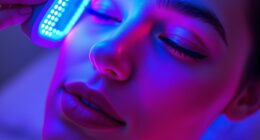Research shows that LED light therapy can help reduce scars by stimulating collagen production, decreasing inflammation, and speeding up skin healing. Different wavelengths target specific skin layers, promoting repair and improving texture. While some studies report noticeable improvements in scar appearance, results depend on the scar type and device quality. If you keep exploring, you’ll discover how this non-invasive treatment might fit into your scar management plan.
Key Takeaways
- Clinical studies indicate LED therapy can improve scar appearance, texture, and color by promoting collagen remodeling.
- Red and near-infrared LED wavelengths stimulate collagen production and cellular regeneration in scar tissue.
- Consistent LED treatments accelerate healing, reduce inflammation, and help fade scar discoloration over time.
- Device quality and tailored protocols significantly influence the effectiveness of LED scar reduction.
- Ongoing research supports LED therapy as a safe, non-invasive option for improving various scar types.
Understanding Scar Formation and Healing Processes
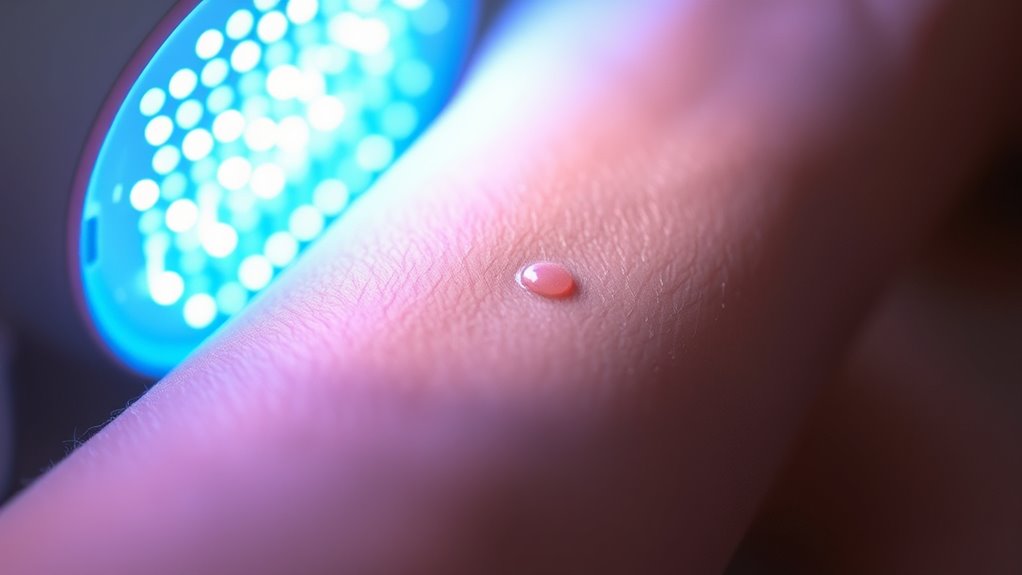
Understanding how scars form and heal is essential to appreciating how LED light therapy can assist in reducing their appearance. When your skin sustains an injury, your body produces scar tissue to close the wound. This scar tissue is made up of an excess of collagen, which creates a dense, fibrous patch that differs from normal skin. During healing, your body undergoes collagen remodeling, where the scar tissue is gradually broken down and replaced with more organized collagen fibers. This process can take months or even years, and the resulting scar may appear raised, discolored, or textured. By understanding this process, you see how targeted treatments like LED light therapy might influence collagen remodeling, encouraging the production of healthier, more evenly distributed collagen fibers in the scar tissue. Additionally, vetted LED therapies are being studied for their potential to modulate inflammation and promote tissue regeneration, further aiding in the healing process.
How LED Light Therapy Works on Skin Tissue
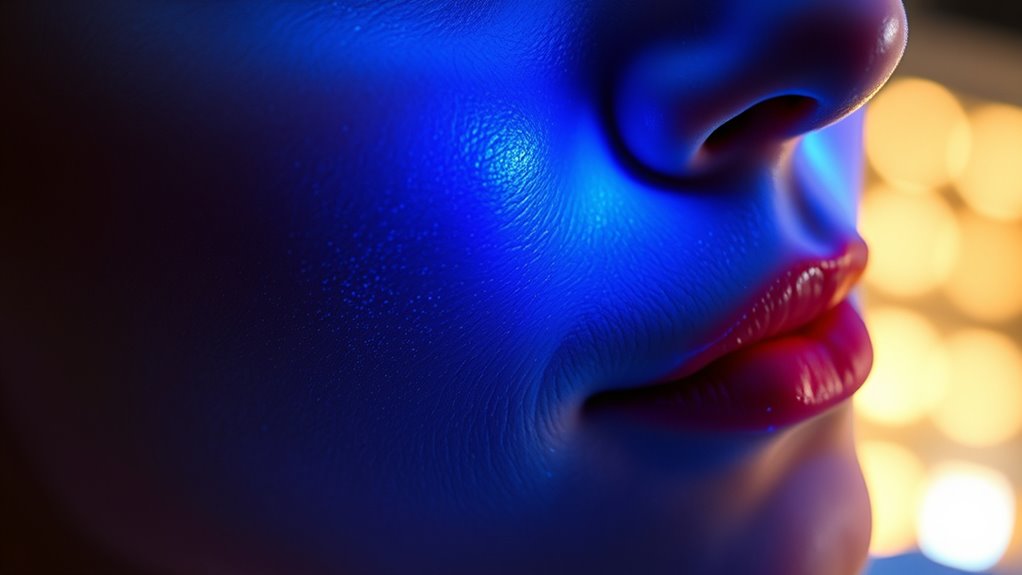
When you receive LED light therapy, the light penetrates your skin to reach deeper layers. This triggers a cellular response, encouraging your cells to repair and regenerate. Understanding how this process works helps explain how LED therapy can reduce scars effectively. Additionally, the technology’s ability to promote cellular regeneration supports skin healing and improves overall tissue health.
Light Penetration Mechanism
LED light therapy works by delivering specific wavelengths of light that penetrate the skin to target underlying tissues. When photons enter your skin, they commence on a journey through layers of tissue, guided by the light’s wavelength. During this process, light scattering occurs, dispersing photons in different directions, which influences how deep the light can reach. The way light penetrates depends on its color and tissue properties, affecting its effectiveness on scars. Understanding this mechanism helps explain why certain wavelengths are chosen for scar treatment. The photons’ journey involves steering through skin’s structure, balancing absorption and scattering, to reach deeper layers where healing processes occur. This precise light penetration is essential for optimizing LED therapy’s impact on scar tissue. Additionally, the contrast ratio of the light can influence how effectively the therapy targets different tissue depths, impacting overall treatment success.
Cellular Response Activation
Light therapy activates your skin’s cells by stimulating their natural processes. When you expose your skin to LED light, it triggers cellular response activation, encouraging repair and regeneration. This process is similar to photodynamic therapy, where light energizes cells to produce healing effects. LED light influences essential functions like collagen production, which reduces scars and improves skin texture. It also helps regulate skin pigmentation, balancing uneven tone and discoloration. By energizing mitochondria within your skin cells, LED therapy boosts ATP production, fueling cellular activity. This increased activity accelerates healing, diminishes inflammation, and promotes a healthier, more even complexion. Additionally, understanding AI’s role in cybersecurity and healthcare highlights how technological innovations are shaping skin treatment advancements. Overall, cellular response activation is key to how LED light therapy promotes scar reduction and skin rejuvenation.
Current Scientific Evidence Supporting LED Therapy for Scars
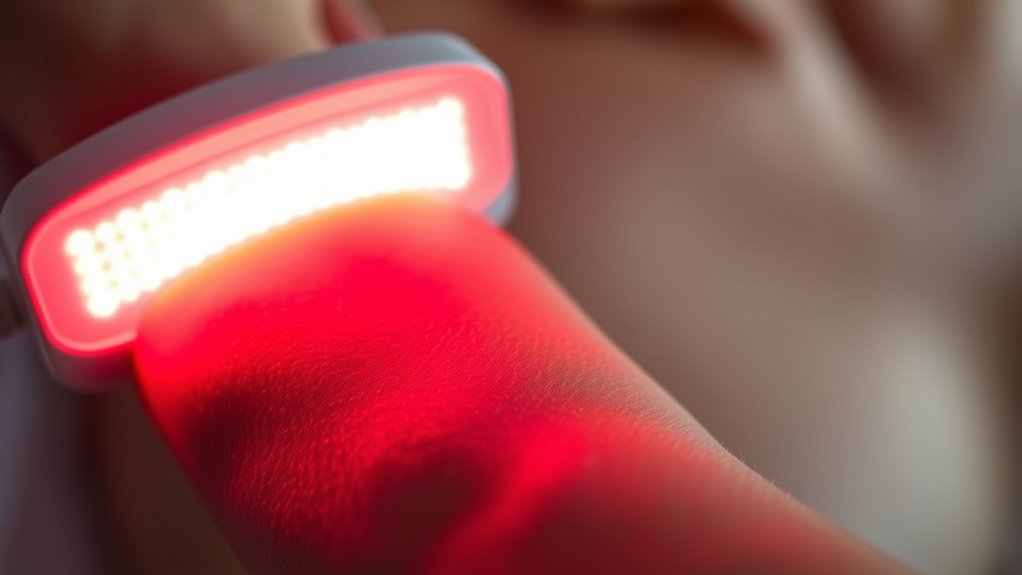
Recent studies show promising results for LED therapy in reducing scars, with many reporting improved appearance and texture. Researchers are also uncovering how LED light influences cellular processes like collagen production and inflammation. These findings help build a solid scientific foundation for using LED therapy as an effective scar treatment.
Clinical Study Findings
Several clinical studies have demonstrated the effectiveness of LED therapy in reducing scar visibility and improving skin texture. These findings highlight the phototherapy benefits that can promote skin rejuvenation and enhance healing. Participants showed noticeable improvements in scar color, texture, and overall appearance after consistent treatments. One study reported that LED therapy accelerated collagen production, resulting in smoother skin. Another found significant reduction in redness and inflammation, aiding in scar fading. These results suggest that LED light therapy can be a safe, non-invasive option for scar management. By stimulating cellular activity, LED therapy supports the skin’s natural healing process, making it a promising approach for those seeking visible scar reduction and skin rejuvenation. Additionally, understanding the role of collagen synthesis in skin repair helps clarify how LED therapy contributes to long-term skin health.
Biological Mechanisms Explored
Understanding how LED therapy promotes scar healing requires examining its biological mechanisms. Two key processes are photothermal effects and photobiomodulation mechanisms. Photothermal effects involve gentle heating that improves blood flow and stimulates cellular activity, aiding tissue repair. Photobiomodulation mechanisms activate cellular functions by influencing mitochondria, increasing ATP production, and reducing inflammation. These processes promote collagen remodeling and tissue regeneration essential for scar reduction. Additionally, advanced sound design techniques are employed to simulate biological responses in educational and research tools.
Types of LED Light Used in Scar Treatment
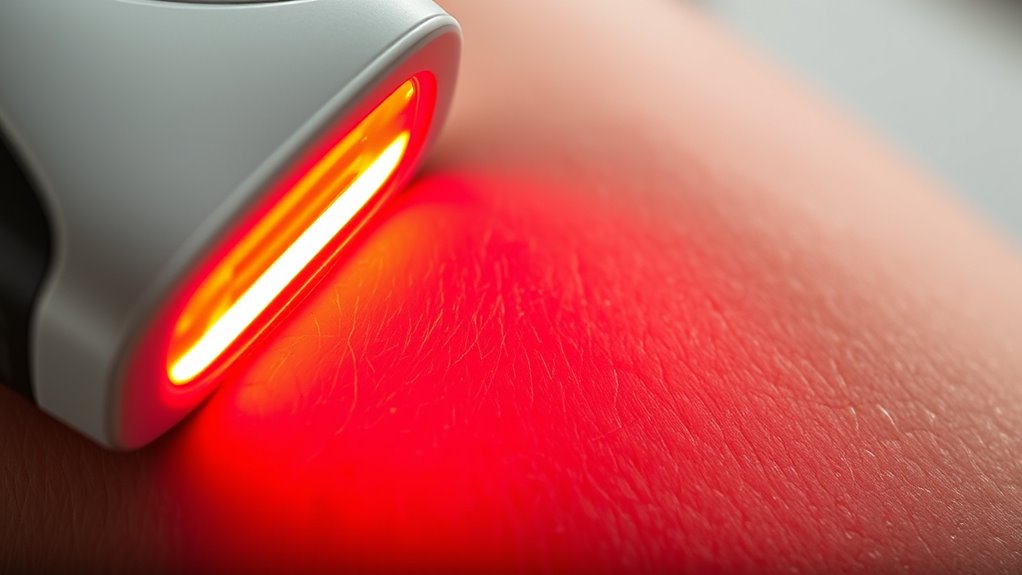
Different types of LED light are used in scar treatment because each targets specific skin concerns and promotes healing in unique ways. The primary options include red, near-infrared, and blue light, each with distinct properties suited for different photobiomodulation applications. Red light is known for stimulating collagen production, reducing inflammation, and enhancing tissue repair, thanks to its specific light wavelength. Near-infrared light penetrates deeper, supporting cellular regeneration and improving blood circulation. Blue light, on the other hand, helps diminish bacteria and prevent infection. Understanding light wavelength specificity is key to choosing the right treatment. These variations allow you to tailor LED therapy to your skin’s needs, optimizing scar healing by targeting different aspects of recovery. Additionally, advances in AI-powered tools are increasingly helping practitioners customize treatments to individual patient needs for better outcomes.
Limitations and Considerations of LED Therapy for Scar Reduction
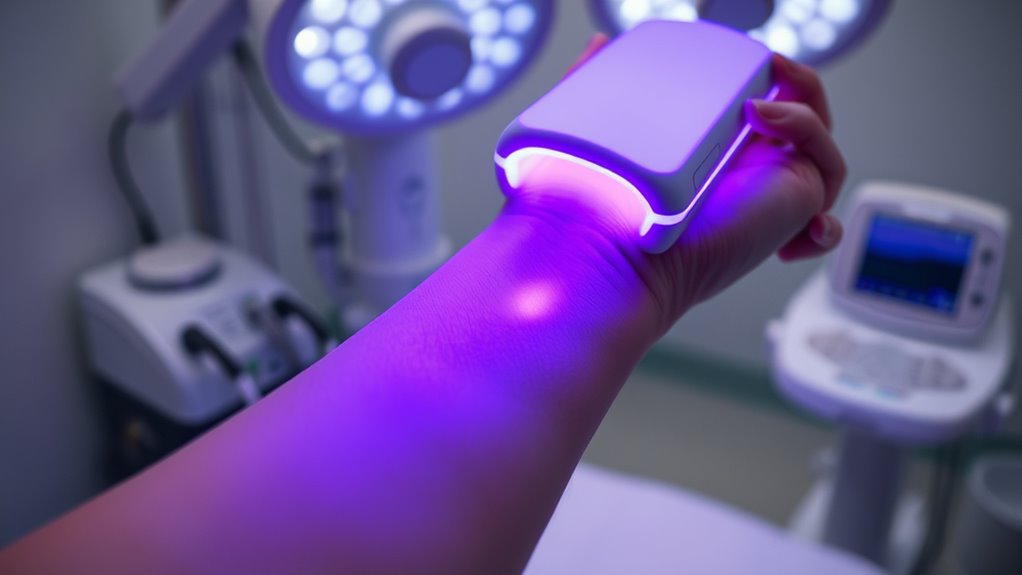
While LED therapy offers promising benefits for scar reduction, it also has limitations you should consider. First, the cost effectiveness can be an obstacle; multiple sessions are often needed, which can add up financially. Not all practitioners have advanced training or experience with LED therapy, affecting treatment quality and safety. Additionally, results vary depending on scar type, age, and skin response, so expectations should be realistic. The therapy’s effectiveness may be limited for deep or thick scars, and consistent treatments are essential to see noticeable changes. You should also consider that LED devices vary in quality, and over-the-counter options might not deliver the same results as professional equipment. Furthermore, the diversity of plant designs and materials in indoor gardening tools highlight the importance of choosing the right equipment for optimal results. Overall, while promising, LED therapy requires careful consideration of these factors for ideal scar management.
Future Directions and Ongoing Research in LED and Scar Management
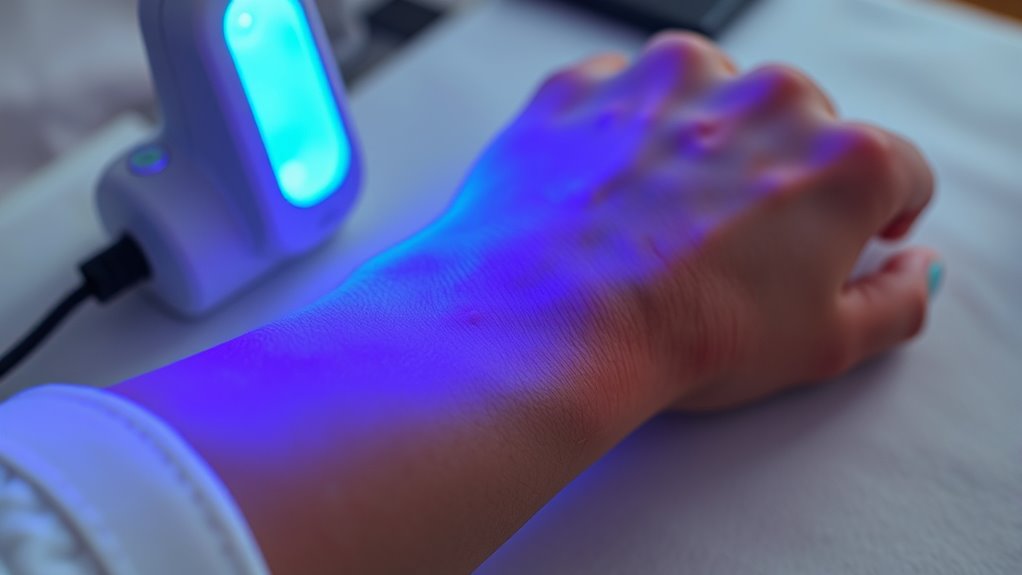
Advancements in LED technology and ongoing research are paving the way for more effective and targeted scar management solutions. Researchers are exploring innovative technological advancements to enhance LED therapy’s precision and efficacy. Future studies aim to identify ideal wavelengths, treatment durations, and protocols tailored to different scar types. However, regulatory challenges remain, as new devices and methods require approval before widespread use. This could slow down the adoption of promising innovations. Despite these hurdles, ongoing research continues to push boundaries, promising more personalized and effective treatments. You can look forward to advancements that may offer quicker healing, reduced scarring, and improved skin quality. Additionally, the development of Vetted – Halloween Product Reviews smarter, adjustable LED devices for personalized treatments is underway.
- Development of smarter, adjustable LED devices for personalized treatments
- Continued research into combining LED therapy with other regenerative techniques
- Navigating regulatory pathways to bring innovations safely to market
Frequently Asked Questions
How Long Does It Typically Take to See Results?
You might start seeing visible improvements after several treatment sessions, but the exact treatment duration varies based on your scar’s size and type. Typically, it takes about 4 to 8 weeks of consistent LED light therapy to notice significant results. Patience is key, as repeated sessions help stimulate collagen production and promote healing, gradually reducing scar appearance and improving skin texture over time.
Are There Any Side Effects From LED Scar Therapy?
You might wonder about potential risks with LED scar therapy. Generally, it’s safe, but some people experience skin irritation or redness afterward. These side effects are usually mild and temporary. To minimize risks, follow your provider’s instructions and avoid overexposure. If you notice persistent discomfort or unusual reactions, consult your dermatologist. Overall, LED light therapy offers a low-risk option for improving scars when used properly.
Can LED Therapy Completely Eliminate Scars?
Think of LED therapy as a gentle gardener tending to your skin. While it can considerably improve the appearance of scars by promoting skin regeneration and softening scar tissue, it usually can’t wipe away scars completely. LED light stimulates healing, but deep or old scars may remain visible. So, you might see a noticeable reduction, but full elimination isn’t guaranteed.
Is LED Therapy Suitable for All Skin Types?
You might wonder if LED light therapy is suitable for your skin. The good news is, it generally offers good skin type compatibility, making it safe for most. However, treatment customization is key; a professional can tailor the session to your specific skin needs, ensuring ideal results. Always consult a specialist to determine if LED therapy fits your skin type and to customize the treatment accordingly.
How Often Should LED Treatments Be Administered?
You might worry about overdoing LED treatments, but with proper guidance, treatment frequency is safe. Typically, the ideal scheduling involves sessions 2-3 times a week initially, then gradually reducing as your skin responds. Consistency is key to seeing results, so follow your provider’s advice on treatment frequency. This approach ensures your skin benefits from consistent stimulation without risking irritation or diminishing returns.
Conclusion
While LED light therapy shows promise in reducing scars, it’s not a silver bullet. The research is still evolving, and results can vary based on individual factors. You should keep in mind that no treatment is a one-size-fits-all solution. Stay informed and keep your eyes open—sometimes, the best way to tackle a problem is to explore all options carefully. With patience and proper guidance, you might find a solution that works for you.




